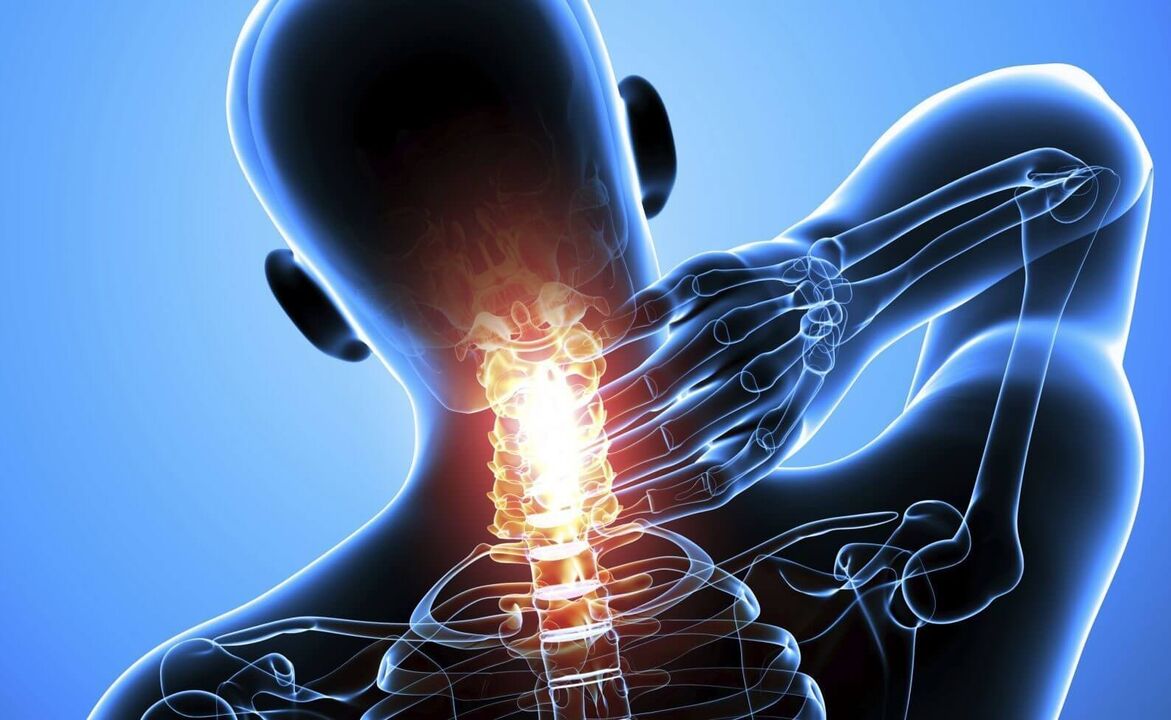
Many people suffer from cervical osteochondrosis.The disease progresses and develops gradually and imperceptibly, but at a not so wonderful moment it manifests itself in a deterioration of general health and headaches.Is it possible to cure cervical osteochondrosis at home using folk remedies?Which expert should you contact for help?
How does osteochondrosis appear and manifest?
The human cervical spine is composed of seven vertebrae.They are connected by intervertebral discs called intervertebral discs, with the nucleus pulposus at the center.It causes unreasonable load on the spine, often in uncomfortable postures, poor blood circulation, frequent muscle spasms, and ultimately leads to degenerative changes in the intervertebral cartilage of the cervical spine.The result of these changes is the development of cracks in the disc cartilage into which the nucleus pulposus is displaced under spinal loading.This displacement can cause compression of nearby structures (spinal parenchyma and spinal nerve roots), resulting in pain.
Anyone who pays attention to their health can spot the first signs of osteochondrosis.Most commonly, cervical osteochondrosis causes pain in the shoulder girdle, back of the head, and neck.In addition, osteochondrosis can cause disruption of cerebral circulation, headaches, dizziness, and even loss of consciousness.
Most commonly, the disorder occurs in people with sedentary lifestyles or sedentary jobs, where the position of the head and neck during the workday is limited to a monotonous range of motion.If a person does not receive qualified treatment in time and tries to overcome the disease on his own at home, the situation gets worse - the distance between the vertebrae narrows, bone growth occurs, leading to permanent partial or complete incapacity to work.
If you experience any of the above symptoms, you should seek help from your doctor.Chiropractors treat a variety of spinal conditions; however, you can only find this type of specialist in large medical centers.In regular clinics, patients with osteochondrosis are treated by a neurologist or, in the absence of a neurologist, a therapist.Only a doctor, after examination, can prescribe treatment (pharmaceutical, folk, comprehensive), adjust or cancel treatment.
Staging and diagnosis of cervical osteochondrosis
The clinical course of osteochondrosis is characterized by three main stages of development, with varying symptoms and extent of disease:
- first stage– Cracks already exist in the disc annulus; under load, the core can move to one side.At this stage, the main symptoms include severe pain and spasm in the neck muscles, numbness of the tongue, dilated pupils, Wright syndrome (tingling and numbness when moving the hand behind the head), Nafziger syndrome (squeezing of the lower roots of the brachial plexus and subclavian artery), neck muscle soreness, etc.;
- second stage– The distance between the vertebrae decreases, the annulus fibrosus dries out, as a result inflammation occurs due to rupture of the capsule.In addition, the edges of the vertebral bodies are covered with osteophytes—specific bone growths.The first stage of symptoms adds to the so-called "head drop" syndrome, which forces the patient to support their head with their hands to relieve pain;
- The third stage– At this stage, complete breakdown of the cartilage, prolapse of the nucleus pulposus, and formation of intervertebral hernia are observed.At this stage, symptoms such as periodic neck pain, headaches, and dizziness will occur. Loss of consciousness will occur when the head turns sharply, and the limbs will periodically "stop listening."
To make a diagnosis, you should seek the help of a neurologist, who will perform an in-depth examination after an initial examination.It should include radiography, cervical and thoracic MRI, angiography, and vascular ultrasonography.The diagnosis of "osteochondrosis" can only be made on the basis of X-ray and MRI data in the presence of changes in the structure of the vertebrae and intervertebral discs.
How does treatment work?

How is cervical osteochondrosis treated?Unfortunately, there is currently no treatment that can completely get rid of this disease.If the patient's condition is satisfactory and he does not need to be hospitalized, he can receive treatment at home. The doctor will provide outpatient treatment, during which the patient will see a doctor and undergo surgery on the agreed date.If the condition is severe, hospitalization may be decided.
Medications prescribed by doctors to treat cervical osteochondrosis usually include the following groups of oral medications:
- Painkillers.Long-term use: 1-2 weeks, 3 times a day, after meals;
- Folk sedatives - motherwort, valerian, St. John's wort.They are mild sedatives that prevent nervous system fatigue from long-term pain.Acceptance time is 1-3 weeks;
- Diuretics.They help reduce swelling in areas of inflammation;
- B vitamins - normalize muscle conduction, help improve metabolic processes in nervous tissue;
- Muscle relaxants - help relax spasmed muscles.
- Chondroprotectants – Medications that help improve cartilage tissue structure and disc performance.
In addition, topically applied gels, ointments, creams and various medicinal or folk liniments have analgesic, warming and distracting effects.
Other treatments

In addition to medicines and folk remedies aimed at relieving the patient's condition, postural treatments were also prescribed.At the stage of exacerbation of osteochondrosis with significant pain, strict bed rest is required, so that the physiological position of the body relieves the load on the spine and relieves pain.Positioning therapy is prescribed for 1-3 days.In addition, during the acute stages of osteochondrosis, doctors and physical therapists recommend special breathing exercises and exercises at home to relieve muscle spasms.
In the subacute stage of cervical osteochondrosis, you can independently perform head turns and smooth bends at home.When muscle spasms occur, massage is a very effective way to relieve pain.You can do it yourself or trust the experts.To prevent this disease, it is useful to have massage twice a year.Then, for the treatment of cervical osteochondrosis, the following means and methods are used:
- gymnastics;
- massage;
- Leech therapy (medicinal leech treatment);
- Wear a special neck brace;
- Vertical cervical traction is performed using a special device.
Diet and maintaining a healthy lifestyle play an important role in the treatment of this disease.Drinks and foods that cause agitation and spasms in a person's spinal muscles must be excluded from the diet.Prohibited drinks and foods include: tea and coffee, alcohol and spicy spices, marinades and smoked foods.Fresh vegetables and fruits, grains and legumes, nuts and hard-boiled eggs, dairy and fermented milk products, and low-fat fish, beef, and poultry are good for cartilage and joint tissue.






















